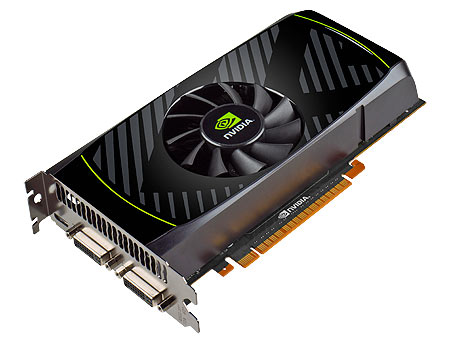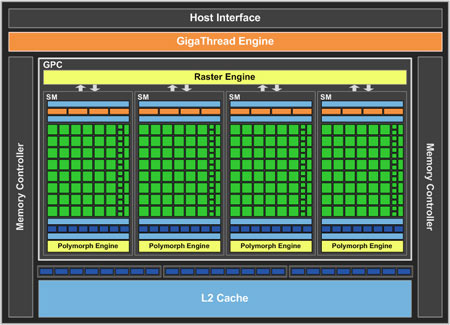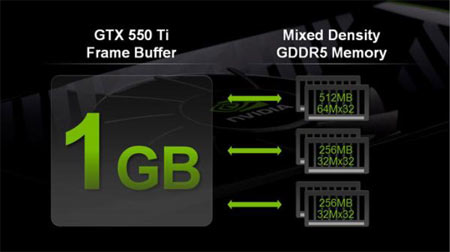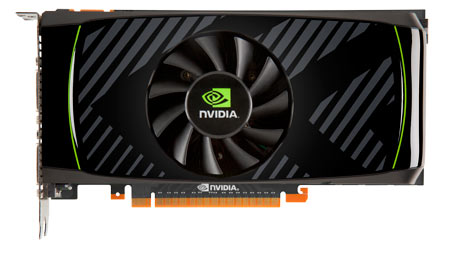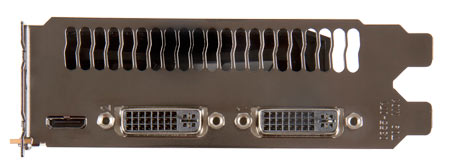Nvidia GeForce GTX 550 Ti Review: Bridging The Budget Gap
Nvidia has a sizable gap in its product line between the GeForce GTS 450 and the GeForce GTX 460 768 MB. The company is filling that gap with an all-new card called the GeForce GTX 550 Ti. Is this product a worthy competitor for AMD's Radeon HD 5770?
Nature Abhors A Vacuum
There is a sizable performance gap between the GeForce GTS 450 and the GeForce GTX 460 768 MB, and AMD's Radeon HD 5770 is positioned smack-dab in the middle of it. The Radeon card currently sells for a few dollars more than the GeForce GTS 450, and yet it offers a notable upgrade, featuring performance on par with the venerable Radeon HD 4870.
Given the current market conditions, AMD's Radeon HD 5770 consequently enjoys free reign over its $125-$150 price range, and has for some time now. The GeForce GTX 460 768 MB recently dropped a few dollars add some pressure, but that Radeon card slid a few bucks to counterattack, too. Up until now, Nvidia's higher-priced GeForce GTX 460 SE was the only thing battling AMD for its position. Unfortunately, relatively sparse availability makes that card more of a stopgap measure.
Today Nvidia introduces its GeForce GTX 550 Ti, a card that should change the status quo by delivering more performance than a GeForce GTS 450. The 550 Ti centers on a respun GPU called GF116, which benefits from many of the same transistor-level changes introduced on GF110 and GF114.
The GF116 has a single Graphics Processing Cluster (GPC), with four Streaming Multiprocessors (SMs). Each SM contains 48 shader cores, four dispatch units, and eight texture units. All told, GF116 employs 192 shader cores, four Polymorph engines (one per SM), and 32 texture units.
Given its familiar specifications, you might be thinking that GF116 is no different from GeForce GTS 450's GF106. And, from an architectural perspective, you’d be right. However, recall that the GTS 450 has one if its ROP partitions disabled at the factory. The GF116 in Nvidia's GeForce GTX 550 Ti does not suffer this indignity, and all three ROP partitions are fully functional. In this respect, it’s similar to the uncut GF106 GPU in Nvidia's GeForce GTX 460M mobile graphics module. With each of the three ROP partitions capable of eight 32-bit integer pixels per clock, we have 24 ROPs and a cumulative 192-bit memory interface. Because of the wider interface and higher memory clocks, the GeForce GTX 550 Ti boasts 70% more bandwidth than the GeForce GTS 450. This should prove to be a big help when anti-aliasing (AA) is enabled.
The new GF116 holds another notable distinction: it can accommodate mixed density memory ICs. This means that the GeForce GTX 550 Ti can be equipped with 1 GB of graphics RAM, unlike previous 192-bit cards with three 64-bit memory partitions limited to 3 x 256 MB (768 MB—not enough to be optimal) or 3 x 512 MB (1.5 GB—too expensive for a budget card).
Now we have a good idea what to expect from the GeForce GTX 550 Ti: it’s a GeForce GTS 450 with a 50% increase of ROPs and memory interface width, and overclocked for good measure. With these specifications, Nvidia claims that the new card provides 28% higher performance than the GTS 450, with 20% more performance per watt. We’ll put those marketing figures to the test in our benchmarks, but for now let’s consider how the new card stacks up against its competition:
Get Tom's Hardware's best news and in-depth reviews, straight to your inbox.
| Header Cell - Column 0 | GeForce GTS 450 | GeForce GTX 550 Ti | GeForce GTX 460 768 MB | Radeon HD 5770 |
|---|---|---|---|---|
| Shader Cores | 192 | 192 | 336 | 800 |
| Texture Units | 32 | 32 | 56 | 40 |
| Full Color ROPs | 16 | 24 | 24 | 16 |
| Graphics Clock | 783 MHz | 900 MHz | 675 MHz | 850 MHz |
| Shader Clock | 1566 MHz | 1800 MHz | 1350 MHz | 850 MHz |
| Memory Clock | 902 MHz | 1025 MHz | 900 MHz | 1200 MHz |
| GDDR5 Memory | 1 GB | 1 GB | 768 MB | 1 GB |
| Memory Interface | 128-bit | 192-bit | 192-bit | 128-bit |
| Memory Bandwidth | 57.7 GB/s | 98.5 GB/s | 86.4 GB/s | 76.8 GB/s |
| Texture Filtering Rate | 25.1 GTex/s | 28.8 GTex/s | 37.8 GTex/s | 34 GTex/s |
| Connectors | 2 x DL-DVI, 1 x mini-HDMI | 2 x DL-DVI, 1 x mini-HDMI | 2 x DL-DVI, 1 x mini-HDMI | 2 x DL-DVI, 1 x HDMI, 1x DisplayPort |
| Form Factor | Dual-slot | Dual-slot | Dual-slot | Dual-slot |
| Power Connectors | 1 x 6-pin | 1 x 6-pin | 2 x 6-pin | 1 x 6-pin |
| Recommended Power Supply | 400 W | 400 W | 450 W | 450 W |
| Thermal Design Power | 106 W | 116 W | 150 W | 108 W |
Making Comparisons
First and foremost, we need to point out that Nvidia confirmed for us that the “GeForce GTX 460 SE & 768 MB are transitioning out of our primary channel lineup.” GeForce GTX 550 Ti is being groomed as the only bridge between the GeForce GTS 450 and GeForce GTX 460 1 GB. Having said that, the company also stated that “end market availability through e-tail can sometimes be found for months after such a transition.” From this, we can expect that GeForce GTX 460 768 MB availability will depend on how quickly the market adopts GeForce GTX 550 Ti.
When we compare the new model to the GeForce GTX 460 768 MB on its way out, we see identical render back-ends, both with a 192-bit memory interface and 24 ROPs. The similarities end there, however. The GF104 GPU in the GeForce GTX 460 is about 50% more powerful, with 336 shader cores and 56 texture units versus the GeForce GTX 550 Ti’s 192 cores and 32 texture units. This difference is mitigated a little by the new card’s higher clock speeds. But we still expect the GeForce GTX 460 768 MB to outperform it by a notable margin.
Comparing in the opposite direction, the GeForce GTS 450 shares an identical shader core and texture unit count with the new card. But its 128-bit memory interface boasts one-third less bandwidth, while the core and memory clocks are both about 120 MHz lower. Given those numbers, we expect the new GeForce GTX 550 Ti to perform significantly faster, just as Nvidia suggests.
The real question is: how will the GeForce GTX 550 Ti compare to AMD's Radeon HD 5770? The 192-bit memory interface should afford a significant memory bandwidth advantage over the 128-bit Radeon, but we think the shader core power remains similar (for those surprised at the difference in quantity, keep in mind that GeForce shader cores are not 1:1 comparable with Radeon shader cores). As such, we expect the GeForce to perform similarly, except in bandwidth-limited situations, where it may show an advantage (for example, when AA is enabled).
The GeForce GTX 550 Ti reference card looks a lot like the GeForce GTS 450 reference card, and according to the specifications, they share the same 8 ¼” length. Having said that, the reference PCB amounts to little more than a suggestion, and both of the launch samples we have for testing are unique overclocked models from their respective manufacturers. Let’s examine them now: meet Zotac's GeForce GTX 550 Ti AMP! Edition and MSI's N550GTX-Ti Cyclone II.
Current page: Nature Abhors A Vacuum
Next Page Zotac's GeForce GTX 550 Ti AMP! EditionDon Woligroski was a former senior hardware editor for Tom's Hardware. He has covered a wide range of PC hardware topics, including CPUs, GPUs, system building, and emerging technologies.
-
AMD_pitbull So, when is the release date on this? Or is it going to be another paper launch by the green team?Reply -
zooted So it consumes more power, and is louder than the 460 768, yet performs just about on par with the 5770? What was the point of this card?Reply -
hardcore_gamer The far superior, less power consuming 6850 is available for only $10 more..This card is pointlessReply -
scook9 zootedSo it consumes more power, and is louder than the 460 768, yet performs just about on par with the 5770? What was the point of this card?To cost a lot clearly lolReply -
dark_lord69 "On par with the 4870"Reply
"The MSRP of the new card is $149"
Well.. in that case I'll stick with my 4870 that I bought for $80. -
sithtis zootedSo it consumes more power, and is louder than the 460 768, yet performs just about on par with the 5770? What was the point of this card?Reply
God i was thinking exactly the same... whats the point of that. a 460 768 cost around 140 and less noise less power better performance... i really really dont get it?
6850 or 460 768 are the cards to get... here in Canada you can get a 5770 for less than 100$
-
K2N hater @DonReply
How about the minimal FPS? Any substantial change on FPS once all eye-candy settings are enabled? -
cleeve K2N hater@DonHow about the minimal FPS? Any substantial change on FPS once all eye-candy settings are enabled?Reply
Minimum FPS readings should be there for most of the games we've benched.
As for adding eye-candy settings, not sure that makes sense for this class of card as it might push FPS down to unpleasant levels.
